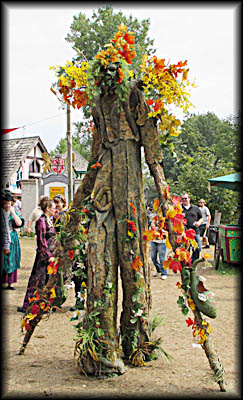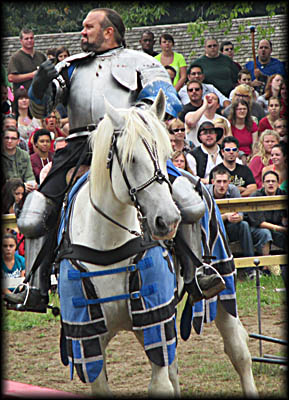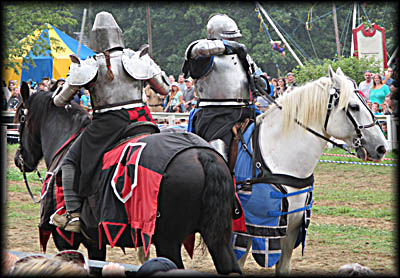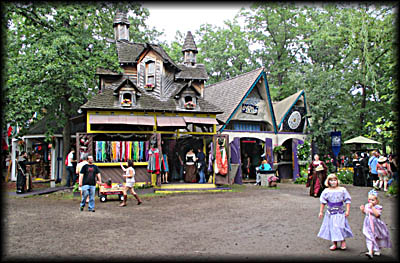Michigan Renaissance Festival


This fellow (or maybe it’s a woman?) quite surprised me.







Before leaving a trip to Michigan to visit a friend, I first stopped at my local library at which I offhandedly mentioned my travel plans to a friend who works there. She asked if I intended to stop at the Michigan Renaissance Festival in Holly, a village south of Flint. I’d never heard of it, so I asked her to write down the address. Two days later my traveling companion and I made our way there.
To my surprise, we didn’t have to pay for parking. Before heading in, I grabbed my umbrella because it looked like it might rain. My traveling companion asked me if I really wanted to carry it around all day. I didn’t, so back into my car it went. Which meant, of course, we later got rained on, explaining why I call this my “anti-rain device.” It only rains when I don’t have it with me.
Like most Renaissance fairs, I expected this one to contain a hodgepodge of tents and flimsy structures taken down at the season’s end. Imagine my surprise, then, when I saw before me a fully constructed Renaissance-era town filled with permanent structures, including a castle and part of a ship where pirates lurk. The grounds, so large you can easily become lost, contain a staggering number of buildings, some humble, others spectacular.
To my surprise, we didn’t have to pay for parking. Before heading in, I grabbed my umbrella because it looked like it might rain. My traveling companion asked me if I really wanted to carry it around all day. I didn’t, so back into my car it went. Which meant, of course, we later got rained on, explaining why I call this my “anti-rain device.” It only rains when I don’t have it with me.
Like most Renaissance fairs, I expected this one to contain a hodgepodge of tents and flimsy structures taken down at the season’s end. Imagine my surprise, then, when I saw before me a fully constructed Renaissance-era town filled with permanent structures, including a castle and part of a ship where pirates lurk. The grounds, so large you can easily become lost, contain a staggering number of buildings, some humble, others spectacular.

For those of you whose inner child screams for you to play dress up, you want to come here. Many visitors wear period costume. If you don’t own the appropriate attire, you needn’t worry: a large variety of stores sell them on site. As you walk about you might also see performers dressed up in something other than traditional Renaissance-era fashion, such as a walking tree (known as the Living Tree) and two statues that move on their own.
While most of the buildings contain stores or sell food, some do have games and entertainment, the latter of which you will find plenty of on the festival’s twelve stages. So many acts and activities exist it would take a week or more just see them all, this not including the one-weekend-only shows, both of which include everything from music to magic to comedy—and often a combination thereof—some family friendly, others not. At least one, the enjoyable Knotty Nauticals pirate show, has two different acts, one for families, the other for adults. We attended the family show, and even that contained quite a bit of innuendo and more mature humor.
My traveling companion and I found ourselves overwhelmed with things to see. We stuck mainly to seeing the shows and visiting stores, some of which contain skilled artisans who make their own wares. Had we felt more ambitious, we could’ve participated in some of that weekend’s activities, including a grape stomp, a fantasy mask competition, or a visit to see some mermaids.
While most of the buildings contain stores or sell food, some do have games and entertainment, the latter of which you will find plenty of on the festival’s twelve stages. So many acts and activities exist it would take a week or more just see them all, this not including the one-weekend-only shows, both of which include everything from music to magic to comedy—and often a combination thereof—some family friendly, others not. At least one, the enjoyable Knotty Nauticals pirate show, has two different acts, one for families, the other for adults. We attended the family show, and even that contained quite a bit of innuendo and more mature humor.
My traveling companion and I found ourselves overwhelmed with things to see. We stuck mainly to seeing the shows and visiting stores, some of which contain skilled artisans who make their own wares. Had we felt more ambitious, we could’ve participated in some of that weekend’s activities, including a grape stomp, a fantasy mask competition, or a visit to see some mermaids.
Of the acts we saw, I liked Zoltan the Adequate the best. A highly talented performer, his show on the Mud Stage included a brilliant mix of magic and comedy, which I won’t go into any detail here so as not to spoil anything. Acts like Zoltan and the Knotty Nauticals pirates, who don’t work exclusively for the festival, usually ask for tips at the end of their shows as a means of increasing their annual income. Those who dedicate their lives to this form of entertainment do it out of passion for their work, not for the money, but they need to eat, too, so give if your budget allows for it. I’d say $5 for each show ought to demonstrate sufficient appreciation.
One of the shows my traveling companion and I watched, one so memorable neither of can remember its name, involved lasers, a cave, and dragons, the last of which figure little in the overall performance. It cost us $2 each to get in, but after seeing it, I concluded those who put it on should’ve paid us that amount just to watch. Unlike many of the festival’s other acts, professional actors, as best I could tell, didn’t grace this show. I would guess the Michigan Renaissance Fair owns this venture and, to save on payroll, hires amateur actors, possibly students looking for seasonal work. Whoever wrote the script needs more practice creating plots, dialog, and a satisfactory resolution. Nor will the real star, the lasers, likely cause you to “ooh” and “ah.”
One of the shows my traveling companion and I watched, one so memorable neither of can remember its name, involved lasers, a cave, and dragons, the last of which figure little in the overall performance. It cost us $2 each to get in, but after seeing it, I concluded those who put it on should’ve paid us that amount just to watch. Unlike many of the festival’s other acts, professional actors, as best I could tell, didn’t grace this show. I would guess the Michigan Renaissance Fair owns this venture and, to save on payroll, hires amateur actors, possibly students looking for seasonal work. Whoever wrote the script needs more practice creating plots, dialog, and a satisfactory resolution. Nor will the real star, the lasers, likely cause you to “ooh” and “ah.”
The jousting tourney, which I’m sure for reasons of liability the festival also operates, did employ talented people. This we watched twice. The first time we couldn’t get close enough to hear or see it well, plus a relentless downpour of rain caused us to cut our viewing short. The second time we attended we got good seats a nd the rain had stopped.
The show, which appears on the Upson Downs Joust Field, has far more than knights just trying to unhorse one another. Four take the field, and each has his own unique personality, demonstrated both his deeds and words, the last of which you hear through a PA system because, as we all know, at tourneys knights traditionally used wireless microphones to speak to the crowd. After introductions, each tries to lance rings, then moves into actual jousting. While clearly quite choreographed, the joust proper still has an unpredictable quality since one never knows what will happen when a lance crashes into the shield of a man on a moving horse. The knights eventually dismount and fight hand-to-hand combat.
I would like to one day return to watch the other show on this field, the Birds of Prey, which I gather involves the falconer the fair keeps on hand. I won’t have time to return this year before the season ends, but I have every intention of doing so next year, this time armed with a list of acts I want to see. I think I’ll even go for an entire weekend.🕜
The show, which appears on the Upson Downs Joust Field, has far more than knights just trying to unhorse one another. Four take the field, and each has his own unique personality, demonstrated both his deeds and words, the last of which you hear through a PA system because, as we all know, at tourneys knights traditionally used wireless microphones to speak to the crowd. After introductions, each tries to lance rings, then moves into actual jousting. While clearly quite choreographed, the joust proper still has an unpredictable quality since one never knows what will happen when a lance crashes into the shield of a man on a moving horse. The knights eventually dismount and fight hand-to-hand combat.
I would like to one day return to watch the other show on this field, the Birds of Prey, which I gather involves the falconer the fair keeps on hand. I won’t have time to return this year before the season ends, but I have every intention of doing so next year, this time armed with a list of acts I want to see. I think I’ll even go for an entire weekend.🕜